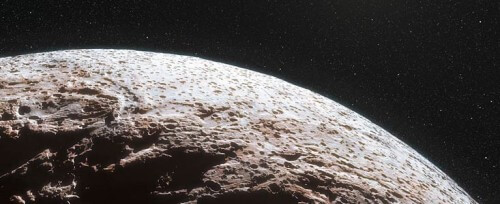An international team of astronomers used telescopes atop South America's highest mountains to observe Maki-Maki when the dwarf planet passed a pale background star in April 2011, creating a brief stellar eclipse that lasted about a minute.

Scientists have no explanation as to why the dwarf planet Maki-Maki has no atmosphere, following a discovery by astronomers using the telescope at the European Southern Observatory (ESO) in La Silla, Chile, and the Paranal Observatory.
An international team of astronomers used telescopes atop South America's highest mountains to observe Maki-Maki when the dwarf planet passed a pale background star in April 2011, creating a brief stellar eclipse that lasted about a minute.
By observing the way the star's light was obscured by the Maki-Maki they were able to measure its size, mass and the Maki-Maki's atmosphere or in this case the absence of it.
"When Maki-Maki passed in front of the star and blocked its light, the star disappeared and reappeared suddenly, instead of fading and getting stronger gradually. This means that the dwarf planet does not have a significant atmosphere," says team leader Jose Luis Ortiz from the Institute of Astrophysics of Andalusia in Spain. "Until recently, we thought there was a good chance that Maki-Maki had an atmosphere - and the fact that there is no sign of it shows that we still have a lot to learn about these mysterious bodies."
Discovered in 2005, Maki-Maki is a dwarf planet about two-thirds the diameter of Pluto. It is about 19 AU from the Sun, farther than Pluto but not as far as Eris which orbits the Sun at a distance of 96 AU. Because of this relative proximity, scientists initially thought that Maki-Maki should have a faint, seasonal atmosphere, similar to that found on Pluto. But now it seems he doesn't have any, at least not anything significant.
Due to its small size, relatively large distance and lack of moons at least as far as it seems, observations of Maki-Maki are difficult to make. The eclipse in 2011 made it possible to perform measurements - even if for one minute - that were not possible until then, including the first ever calculation of the density of the dwarf planet and its light reflectance (albedo).
As it stands now, the albedo of maki-maki is 0.77, about the same as that of dirty snow. Light reflectivity is higher than that of Pluto but lower than that of Eris. Its density is estimated at 1.7 ± 0.3 grams per cubic meter, which indicates that the composition is mostly ice, with a few rocks.
"The new observations we made greatly improved our knowledge of the largest icy body in the solar system - Maki-Maki, and we will be able to use this information when we investigate in depth the fascinating objects found in this region of space." Ortiz concludes.

One response
Haha every time I read the name "Maki-Maki" I laugh... must be its translation in ancient Indian is: "I have purple poop"... or something like that...